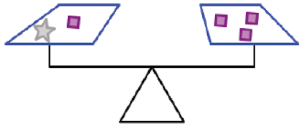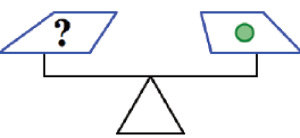1.2 Discussion
Now that you have worked through Examples 1.2.1 through 1.2.5 in two different ways, let us consider the following question:
Which method did you think was easier: using shapes and pictures OR using variables and algebraic expressions? Your responses may vary from example to example so address each one separately. In each case, discuss why you think the chosen method was easier. The examples are copied below for you to annotate.
Example 1.2.1 revisited (click on the triangle/arrow to expand)
a) Based on the scale picture what can you say about the relationship between the weight of a star and the weights of a circle? Explain how you were able to determine the results.

b) Based on the scale picture, what can you say about the relationship between the weight of a star and the weight of a square? Explain how you were able to determine the results.

Example 1.2.2 revisited (click on the triangle/arrow to expand)
Use Figure 1 to answer the questions that follow.


a) Which shape weighs the most? Justify your answer.
b) Which scale is holding the most total weight? How can you prove this?
Example 1.2.3 revisited (click on the triangle/arrow to expand)
Use the first two scale pictures in the Figure 2 to gather enough information to determine how many squares go in place of the question mark in the third scale picture.

Example 1.2.4 revisited (click on the triangle/arrow to expand)
Use the three scale pictures in Figure 3 to gather information to determine what shapes will balance the scale below. That is, what can we put in place of the question mark that will balance the scale? Try to come up with more than one answer. Explain how you arrived at your answers.

Example 1.2.5 revisited (click on the triangle/arrow to expand)
Use the scale pictures in Figure 4 to gather information to determine how many squares go in place of each of the question marks in parts (a), (b) and (c) below.

a)

b)

c)

a letter that represents a quantity that may vary

